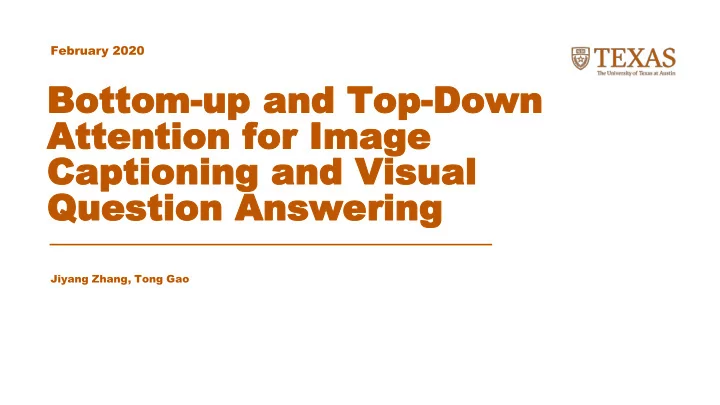

February 2020 Botto Bottom-up up and Top and Top-Down Down Attention f Atten tion for Image or Image Captioning Captioning and Visua and Visual l Ques Question Answ tion Answering ering Jiyang Zhang, Tong Gao
Background Image captioning and visual question answering are • problems combining image and language understanding. To solve these problems, it is often necessary to perform • visual processing, or even reasoning to generate high quality outputs. Most conventional visual attention mechanisms are of the • top-down variety: Given context, model attend to one or more layers of CNN.
Problem CNN processes input regions • in a uniform grid space, regardless of the content of the image Attention on grid space - only • on partial object
Our Model Top-down mechanism: use task-specific context to predict an • attention distribution over the image Bottom-up mechanism : use Faster R-CNN to propose a set of • salient image regions
Advantages With Faster R-CNN, the model • attends to the full object now. We are able to pre-train it on • object detection datasets, leveraging cross-domain knowledge.
Overview Bottom-up Attention Model - Top-down Attention Model - Captioning Model - VQA Model - Datasets - Results - Conclusion - Critique - Discussion -
Bottom-up Attention Model
Bottom-up Attention Model (mean pooling)
Bottom-up Attention Model Object (mean pooling) Embeddings Linear + Softmax 5. Final classification score (attributes) Attribute
Captioning Model (Attention LSTM) Last timestep Word Mean output (from Embedding Pooling language LSTM) (learned)
Captioning Model (Attention LSTM) Last timestep Mean Word output (from Pooling Embedding language LSTM) (learned)
Captioning Model (Attention LSTM) Last timestep Mean Word output (from Pooling Embedding language LSTM) (learned)
Objective
Objective
VQA Model
VQA Model Truncate
VQA Model Confidence score for every candidate answers, trained with binary cross entropy loss
Dataset Visual Genome dataset • • pretrain bottom-up attention model • the dataset contains 108K images densely annotated, containing objects, attributes and relationships, and visual question answers • ensure that any images found in both datasets are contained in the same split • augment VQA v2.0 training data Microsoft COCO Dataset • • Image caption task VQA v2.0 Dataset • • Visual Question Answering task • attempts to minimize the effectiveness of learning dataset priors by balancing the answers to each question
ResNet Baseline To quantify the impact of bottom-up attention • Uses a ResNet CNN pretrained on ImageNet to encode each • image in place of the bottom-up attention Image caption: use the final convolutional layer of Resnet- • 101, resize the output to a fixed size spatial representation of 10×10 VQA: varying the size of output representations, 14×14, 7×7, • 1×1
Image caption results
SPICE: Semantic Propositional Image Caption Evaluation
dependency parse trees semantic scene graph
VQA Results
VQA Results
Qualitative Analysis
Errors
Critique • Randomly initialized word embedding in image captioning task, but GloVe vectors on VQA model? • Why don't merge overlapping classes when processing Visual Genome Dataset? - Perform stemming to reduce the class size (e.g. trees->tree) - Use WordNet to merge synonyms • The model submitted to VQA challenge is trained with additional Q&A from Visual Genome - cheating? • Also - they use 30 ensembled models on the test evaluation server? • Their image captioning model forces the decoder to generate unique words in a row, but some prepositions can appear for twice or more - only filter nouns
Critique • Curious about the length of image features with relation to the performance. Will it be harder to generate captions for more complicated images. • Evaluation only includes automatic metrics, needs more human evaluation in image caption generation task, like relevance, expressiveness, concreteness, creativity. • Need analysis of results of different types of questions, e.g. “Is the” or “what is” questions. And it will be interesting to show the distribution of age of questions for different levels of accuracies achieved by our system, estimate the model can perform as well as humans in which age. • Other things could try: • Is it possible to also apply attention to words in the question for VQA?
Thank you!
Non-maximum Suppression
Why Sigmoid?
What is SPICE? ● (a) A young girl standing on top of a tennis court. ● (b) A giraffe standing on top of a green field. High n-gram similarity (c) A shiny metal pot filled with some diced veggies. • (d) The pan on the stove has chopped vegetables in it. • Low n-gram similarity
Recommend
More recommend